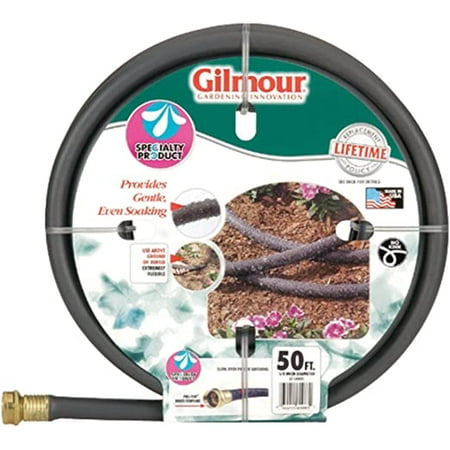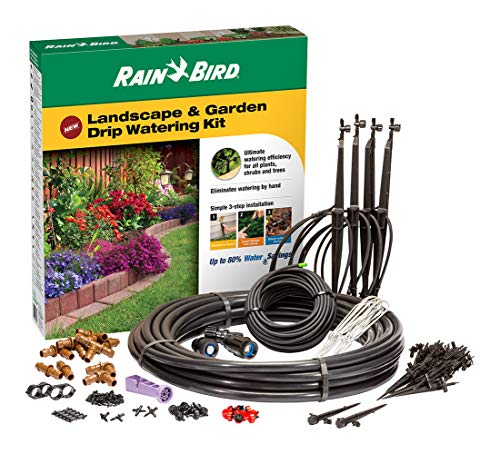How to choose between a drip irrigation system and a soaker hose – which is best for watering plants during summer?
Discover the pros and cons of these watering systems and the types of yards they are most suitable for


There are lots of options to consider to give you a helping hand when watering plants. If watering by hand, using a watering can or garden hose can be time-consuming and inefficient, and so many gardeners turn to sprinklers, drip irrigation, and soaker hoses to make life easier.
Sprinklers do help, but they are also inefficient. Drip irrigation systems and soaker hoses are much more efficient and designed to deliver water where plants most need it. You lose less to evaporation and, when you water plants, you can relax knowing the watering is streamlined and effective.
Both methods have advantages and disadvantages and are suitable for different situations and garden setups. Which is best for you may depend on whether you have flower beds, vegetable gardens, raised beds, or container gardens, and your budget.

Drip irrigation heads emit water directly into the soil
Drip irrigation system vs soaker hose
Both drip irrigation and soaker hoses can be great methods of watering plants. We hear from experts to reveal the pros and cons to help you decide between the two solutions.
When and why to use a soaker hose

Soaker hoses seep water along their length
Advantages of a soaker hose:
- Simple to set up
- Budget-friendly
- Great for smaller gardens
- It provides water where you need it most
Disadvantages of a soaker hose:
- It needs replacing every few years
- Prone to clogging
- Can struggle with inconsistent water pressure
- Not as versatile as drip systems
Soaker hoses are an efficient way to water a garden deeply. The porous garden hoses are covered in thousands of tiny holes and water seeps consistently along the full length. Soaker hoses are good for supplying a steady stream of water directly to the base of plants, getting water down to the roots where it is needed most and reducing the threat of fungal diseases, like powdery mildew, that comes from wet foliage and overhead watering.
Design expertise in your inbox – from inspiring decorating ideas and beautiful celebrity homes to practical gardening advice and shopping round-ups.
‘Soaker hoses are super easy to install, budget-friendly, and flexible, making sure your plants get even water all along their length,’ says Marek Bowers, founder at Bolder Green. ‘However, they’re not as precise and don’t give you as much control over water delivery. Plus, they can wear out over time, especially in the sun.’
Dennis Sons, owner and CEO of TN Nursery, claims that soaker hoses are ideal for evenly watering flower beds and rows of plants. ‘In my experience, soaker hoses work well in traditional garden beds and more significant, less complex layouts, where simplicity and coverage are essential,’ he adds. ‘However, one downside is that they can sometimes be less efficient with water, especially if I don't monitor them closely. They can also be prone to clogging if my water has a lot of sediment.’
As the soaker hoses provide water in a focused area, that moisture goes to the plants. It helps avoid lots of weeds sprouting through watering a larger area. Soaker hoses can be used in flower beds, vegetable gardens, or raised beds to efficiently water plants. The hoses can even be easily moved around the garden.

Marek is a sustainable landscaper and an expert on California and Colorado low-water rebates. Marek's website, Bolder Green, is a guide to eco-friendly gardening. Through his articles on drought-tolerant landscaping and xeriscaping, readers will learn how to design stunning gardens that conserve water and support wildlife, all while adding beauty to their outdoor spaces.
Shop soaker hoses
When and why to use a drip irrigation system

Drip irrigation systems water individual plants
Advantages of drip irrigation:
- Customizable
- More precise control
- Minimizes water waste
- Ideal for container gardens
Disadvantages of drip irrigation:
- More up-front cost
- More set-up time
- Needs maintenance to check emitters
Drip irrigation systems feature emitters attached along a series of connectors that slowly release water into the soil. They can precisely and efficiently supply all manner of plants with moisture. Drip systems are very versatile and highly customizable, making them suitable for beds, borders, vegetable gardens, raised beds, and container gardens.
‘If you have a larger collection of pots and planters, drip irrigation could be a better fit,' says Victoria Cummins, a senior editor at PlantWhisperer. ‘You can also customize the configuration, turning it on and off for different sections of your container garden. This is handy if some of your pots are on a slope.
Drip irrigation systems are more suitable for larger gardens and ones with more intricate designs. The ability to turn on certain sections means that plants with different watering needs can be included on one network, but you can switch off parts to avoid overwatering plants.
However, the initial cost of drip irrigation systems is higher and they can be more time-consuming to set up - featuring different components that need to be installed. Another downside, as pointed out by Dennis Sons, is maintenance. He claims: ‘Maintenance can be more involved, as I need to check for clogs and ensure the emitters are functioning correctly.’
Drip systems may be a highly economical option if you are looking for a watering system that can provide individual plants with moisture - such as in a large, intricate garden, a sloping site, or for watering plants in containers.
The initial cost may be higher, but the system can last for many years with the right maintenance. If they do have issues, the systems can be fixed rather than just having to be replaced.
There are also more budget-friendly DIY garden watering systems or DIY drip irrigation tools for pots you may consider for short-term use, such as to water plants while away on vacation.

Victoria Cummins is a Senior Editor at PlantWhisperer and a gardening expert, specializes in permaculture. Her work focuses on building soil quality, cultivating fruit trees, and wild harvesting. Collaborating with homeowners, landowners, farmers, gardeners, and communities, she dedicates her expertise to healing landscapes and enhancing food production to create resilient, sustainable environments.
Shop drip irrigation systems and accessories
Soaker hose vs drip irrigation - how to choose between them?

Drip irrigation and soaker hoses can deeply water the base of plants
A choice between a drip irrigation system or a soaker hose will likely come down to garden size, style, and budget. Both systems have benefits and drawbacks, though they can be matched to specific types and styles of gardens to keep the soil moist in summer and benefit plants.
The garden size, set-up, topography, water pressure, and cost need to be considered to pick the best solution for your needs. Whether you grow perennials and shrubs in large flower beds, vegetables in raised beds, or flowering plants in containers will all impact any decision.
Soaker hoses will be a practical and efficient option for smaller backyards and flat ground - including raised beds, while drip irrigation can work best for large and sloping sites.
‘For a small, flat container garden on a budget, soaker hoses are usually the top pick,’ says Victoria Cummins. ‘But if you have a bigger, more spread out collection of pots and planters, and don't mind investing some time and money upfront, drip irrigation offers precise, adaptable watering that will last for years.’
FAQs
Should you remove a soaker hose in winter?
A soaker hose, and a drip irrigation system, can be left outside during winter, however, it is safer to remove the hose and store it away. Just as winterizing a sprinkler system is important to prevent damage, water in the hose or connectors of a soaker hose or drip system can cause damage when it freezes. It’ll either be costly to repair or you will need to replace the hose. As a soaker hose is easily movable, it is recommended to drain it and store it away for winter. Drip irrigation systems left outside for winter should be fully drained of all water two or three weeks ahead of the frosts.
Why is it better to use a soaker hose instead of a sprinkler?
A soaker hose is much more focused on watering plants deeply in a flower bed or vegetable garden. It supplies a steady water supply directly at the root level to benefit plants. Sprinklers are more suited to watering larger areas, such as a lawn. A sprinkler system can water garden beds with flowers and vegetables, however, it is a less efficient method and wet foliage can leave plants susceptible to fungal diseases.
Which is better, a flat or round soaker hose?
Soaker hoses are either flat or round. Flat ones are often plastic and have holes down one side of their length. They are best suited to be used in straight lines and a flat soaker hose is easier to roll up and store. Round soaker hoses are longer-lasting, more durable than flat ones, and more expensive. It is easier to snake a round hose around plants, but it will take up more storage space. Which is best for you will depend on the size and set-up of your garden and your budget.
Not watering deeply is a common garden watering mistake that can affect the health of plants. Deep watering encourages a strong root system and helps plants cope better with dry periods. Both drip irrigation and soaker hoses are ideal for watering the soil deeply, however, any time you water with a hose or watering can you should also give plants a deep soaking less often rather than adopting a little-and-often approach.

Drew has worked as a writer since 2008 and was also a professional gardener for many years. As a trained horticulturist, he worked in prestigious historic gardens, including Hanbury Hall and the world-famous Hidcote Manor Garden. He also spent time as a specialist kitchen gardener at Soho Farmhouse and Netherby Hall, where he grew vegetables, fruit, herbs, and cut flowers for restaurants. Drew has written for numerous print and online publications and is an allotment holder and garden blogger. He is shortlisted for the Digital Gardening Writer of the Year at the 2025 Garden Media Guild Awards.





